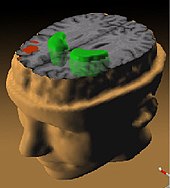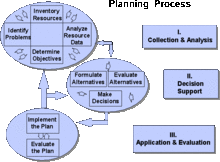Planning
| Part of a series on |
| Planning |
|---|
| Planning |
| Psychology |
| Business |
| Automated planning and scheduling |
|
|
Planning is the process of thinking regarding the activities required to achieve a desired goal. Planning is based on foresight, the fundamental capacity for mental time travel. Some researchers regard the evolution of forethought - the capacity to think ahead - as a prime mover in human evolution.[1] Planning is a fundamental property of intelligent behavior.[citation needed] It involves the use of logic and imagination to visualize not only a desired result, but the steps necessary to achieve that result.
An important aspect of planning is its relationship to forecasting. Forecasting aims to predict what the future will look like, while planning imagines what the future could look like.
Planning according to established principles - most notably since the early-20th century[2] - forms a core part of many professional occupations, particularly in fields such as management and business. Once people have developed a plan, they can measure and assess progress, efficiency and effectiveness. As circumstances change, plans may need to be modified or even abandoned.
In light of the popularity of the concept of planning, some adherents of the idea advocate planning for unplannable eventualities.[3][4]
Psychology
[edit]Planning has been modeled in terms of intentions: deciding what tasks one might wish to do; tenacity: continuing towards a goal in the face of difficulty and flexibility, adapting one's approach in response implementation.[5]: 89 An implementation intention is a specification of behavior that an individual believes to be correlated with a goal will take place, such as at a particular time or in a particular place. Implementation intentions are distinguished from goal intentions, which specifies an outcome such as running a marathon.[5]: 89
Neurology
[edit]
Planning is one of the executive functions of the brain, encompassing the neurological processes involved in the formulation, evaluation and selection of a sequence of thoughts and actions to achieve a desired goal. Various studies utilizing a combination of neuropsychological, neuropharmacological and functional neuroimaging approaches have suggested there is a positive relationship between impaired planning ability and damage to the frontal lobe.
A specific area within the mid-dorsolateral frontal cortex located in the frontal lobe has been implicated as playing an intrinsic role in both cognitive planning and associated executive traits such as working memory.
Disruption of the neural pathways, via various mechanisms such as traumatic brain injury, or the effects of neurodegenerative diseases between this area of the frontal cortex and the basal ganglia, specifically the striatum (corticostriatal pathway), may disrupt the processes required for normal planning function.[6]
Individuals who were born very low birth weight (<1500 grams) and extremely low birth weight are at greater risk for various cognitive deficits including planning ability.[7][8]
The other region activated in planning process is default mode network which contributes to activity of remembering the past and imagine the future.[9] This network distributed set of regions that involve association cortex and paralimbic region but spare sensory and motor cortex this is make possible planning process disruption by active task that uses sensory and motoric regions.[10][11]
Neuropsychological tests
[edit]
There are a variety of neuropsychological tests which can be used to measure variance of planning ability between the subject and controls.
- Tower of Hanoi, a puzzle invented in 1883 by the French mathematician Édouard Lucas. There are different variations of the puzzle: the classic version consists of three rods and usually seven to nine discs of subsequently smaller size. Planning is a key component of the problem-solving skills necessary to achieve the objective, which is to move the entire stack to another rod, obeying the following rules:

- Tower of London is another test that was developed in 1992 by Tim Shallice specifically to detect deficits in planning as may occur with damage to the frontal lobe. Test participants with damage to the left anterior frontal lobe demonstrated planning deficits (i.e., greater number of moves required for solution).
Test participants with damage to the right anterior, and left or right posterior areas of the frontal lobes, showed no impairment. The results implicating the left anterior frontal lobes involvement in solving the Tower of London were supported in concomitant neuroimaging studies which also showed a reduction in regional cerebral blood flow to the left pre-frontal lobe. For the number of moves, a significant negative correlation was observed for the left prefrontal area: i.e. subjects that took more time planning their moves showed greater activation in the left prefrontal area.[14]
Planning theories
[edit]Business
[edit]

Patrick Montana and Bruce Charnov outline a three-step result-oriented process for planning:[15]
- Choosing a destination
- Evaluating alternative routes
- Deciding the specific course of the plan
In organizations, planning can become a management process, concerned with defining goals for a future direction and determining on the missions and resources to achieve those targets. To meet the goals, managers may develop plans such as a business plan or a marketing plan. Planning always has a purpose. The purpose may involve the achievement of certain goals or targets: efficient use of resources, reducing risk, expanding the organization and its assets, etc.
Public policy
[edit]Public policies include laws, rules, decisions, and decrees. Public policy can be defined as efforts to tackle social issues via policymaking.[16] A policy is crafted with a specific goal in mind in order to address a societal problem that has been prioritized by the government.[17]
Public policy planning includes environmental, land use, regional, urban and spatial planning. In many countries, the operation of a town and country planning system is often referred to as "planning" and the professionals which operate the system are known as "planners".
It is a conscious as well as sub-conscious activity. It is "an anticipatory decision making process" that helps in coping with complexities. It is deciding future course of action from amongst alternatives. It is a process that involves making and evaluating each set of interrelated decisions. It is selection of missions, objectives and "translation of knowledge into action." A planned performance brings better results compared to an unplanned one. A manager's job is planning, monitoring and controlling. Planning and goal setting are important traits of an organization. It is done at all levels of the organization. Planning includes the plan, the thought process, action, and implementation. Planning gives more power over the future. Planning is deciding in advance what to do, how to do it, when to do it, and who should do it. This bridges the gap from where the organization is to where it wants to be. The planning function involves establishing goals and arranging them in logical order. An organization that plans well achieves goals faster than one that does not plan before implementation.
Personal
[edit]Planning is not just a professional activity: it is a feature of everyday life, whether for career advancement, organizing an event or even just getting through a busy day.
Alternatives to planning
[edit]Opportunism can supplement or replace planning.[18][19]
Types of planning
[edit]- Automated planning and scheduling
- Business plan
- Central planning
- Collaborative planning, forecasting, and replenishment
- Comprehensive planning
- Contingency planning
- Economic planning
- Enterprise architecture planning
- Environmental planning
- Event planning
- Family planning
- Financial planning
- Land use planning
- Landscape planning
- Lesson planning
- Marketing plan
- Maintenance
- Network resource planning
- Operational planning
- Planning Domain Definition Language
- Regional planning
- Site planning
- Spatial planning
- Strategic planning
- Succession planning
- Time management
- Urban planning
See also
[edit]References
[edit]- ^ Suddendorf T, Corballis MC (June 2007). "The evolution of foresight: What is mental time travel, and is it unique to humans?" (PDF). The Behavioral and Brain Sciences. 30 (3): 299–313, discussion 313–51. doi:10.1017/S0140525X07001975. PMID 17963565.
We maintain that the emergence of mental time travel in evolution was a crucial step toward our current success.
- ^
Friedman, Elisha M. (6 July 2017) [1933]. Russia in Transition: A Business Man's Appraisal. RLE: Early Western Responses to Soviet Russia (reprint ed.). Abingdon: Taylor & Francis. p. 61. ISBN 9781351618625. Retrieved 27 January 2024.
One of the cardinal doctrines of the Marxian system is the necessity for planning. [...] Lenin was the genius back of the Soviets' ideas of a planned economy.
- ^ Read, Steven R. (1990). Planning for the Unplannable: Branches, Sequels and Reserves. School of Advanced Military Studies, U.S. Army Command and General Staff College. Retrieved 27 January 2024.
- ^ Coffey, William R. (10 March 2011). Industrial Emergency Planning: Planning for the Unplannable. John Wiley & Sons, Incorporated. ISBN 9780470053669. Retrieved 27 January 2024.
- ^ a b Bieleke, Maik; Keller, Lucas; Gollwitzer, Peter M. (2021-01-02). "If-then planning". European Review of Social Psychology. 32 (1): 88–122. doi:10.1080/10463283.2020.1808936. ISSN 1046-3283.
- ^ Owen, AM (Nov 1997). "Cognitive planning in humans: neuropsychological, neuroanatomical and neuropharmacological perspectives". Prog Neurobiol. 53 (4): 431–50. doi:10.1016/s0301-0082(97)00042-7. PMID 9421831. S2CID 69523.
- ^ Harvey, JM; O'Callaghan, MJ; Mohay, H (May 1999). "Executive function of children with extremely low birthweight: a case control study". Dev Med Child Neurol. 41 (5): 292–7. doi:10.1017/s0012162299000663. PMID 10378753.
- ^ Aarnoudse-Moens, CS; Weisglas-Kuperus, N; van Goudoever, JB; Oosterlaan, J (Aug 2009). "Meta-analysis of neurobehavioral outcomes in very preterm and/or very low birth weight children" (PDF). Pediatrics. 124 (2): 717–28. doi:10.1542/peds.2008-2816. PMID 19651588. S2CID 18012434.
- ^ Buckner, Randy L. (2013-09-30). "The brain's default network: origins and implications for the study of psychosis". Dialogues in Clinical Neuroscience. 15 (3): 351–358. doi:10.31887/dcns.2013.15.3/rbuckner. ISSN 1958-5969. PMC 3811106. PMID 24174906.
- ^ Lejko, Nena; Tumati, Shankar; Opmeer, Esther M.; Marsman, Jan-Bernard C.; Reesink, Fransje E.; De Deyn, Peter P.; Aleman, André; Ćurčić-Blake, Branislava (March 2022). "Planning in amnestic mild cognitive impairment: an fMRI study" (PDF). Experimental Gerontology. 159: 111673. doi:10.1016/j.exger.2021.111673. ISSN 0531-5565. PMID 34958871.
- ^ Shulman, Gordon L.; Fiez, Julie A.; Corbetta, Maurizio; Buckner, Randy L.; Miezin, Francis M.; Raichle, Marcus E.; Petersen, Steven E. (1997). "Common Blood Flow Changes across Visual Tasks: II. Decreases in Cerebral Cortex" (PDF). Journal of Cognitive Neuroscience. 9 (5): 648–663. doi:10.1162/jocn.1997.9.5.648. ISSN 0898-929X. PMID 23965122. S2CID 25599950.
- ^ Welsh, MC; Huizinga, M (Jun 2001). "The development and preliminary validation of the Tower of Hanoi-revised" (PDF). Assessment. 8 (2): 167–76. doi:10.1177/107319110100800205. PMID 11428696. S2CID 27931772.
- ^ Anderson, JR; Albert, MV; Fincham, JM (Aug 2005). "Tracing problem solving in real time: fMRI analysis of the subject-paced Tower of Hanoi". J Cogn Neurosci. 17 (8): 1261–74. CiteSeerX 10.1.1.139.8424. doi:10.1162/0898929055002427. PMID 16197682. S2CID 7567982.
- ^ Shallice, T. (1982). "Specific impairments of planning". Philosophical Transactions of the Royal Society of London. Series B, Biological Sciences. 298 (1089): 199–209. Bibcode:1982RSPTB.298..199S. doi:10.1098/rstb.1982.0082. PMID 6125971.
- ^ Barron's Management, Barron's Business Review book fifth edition: Patrick J. Montana and Bruce H. Charnov
- ^ Yalmanov, N. (2021). "Public Policy and Policy-Making". Kne Social Sciences. doi:10.18502/kss.v5i2.8400.
- ^ Knoepfel, Peter; Larrue, Corinne; Varone, Frédéric; Hill, Michael (2011). "Public policy". Public policy analysis. pp. 20–37. doi:10.1332/policypress/9781861349071.003.0002. ISBN 978-1-86134-907-1.
- ^ For example:
Faludi, Andreas (1987). A Decision-centred View of Environmental Planning. Urban and Regional Planning Series. Vol. 38. Oxford: Elsevier (published 2013). p. 208. ISBN 9781483286488. Retrieved 2018-07-11.
Plans which do not allow for [accommodating the public and private interest in land development] will be neglected. So the effect is the opposite of what is intended: opportunism.
- ^ Hammond, Kristian; Converse, Timothy; Marks, Mitchell; Seifert, Colleen M. (1993). "Opportunism and Learning" (PDF). Machine Learning. 10 (3): 279–309. doi:10.1023/A:1022639127361. S2CID 14604957.
Further reading
[edit]- Allmendinger, Phil; Gunder, Michael (2005). "Applying Lacanian Insight and a Dash of Derridean Deconstruction to Planning's 'Dark Side'". Planning Theory. 4: 87–112. doi:10.1177/1473095205051444. S2CID 145100234.
- Bazin, A. (2012). Bilateral and multilateral planning: Best practices and lessons learned. Strategos.
- Das, J P, Binod C Kar, Rauno K Parrila. Cognitive Planning: The Psychological Basis of Intelligent Behaviour. Sage Publications Pvt. Ltd; illustrated edition. English ISBN 0-8039-9287-4 ISBN 978-0-8039-9287-0
- Gunder, Michael (2003). "Passionate Planning for the Others' Desire: An Agonistic Response to the Dark Side of Planning". Progress in Planning. 60 (3): 235–319. doi:10.1016/s0305-9006(02)00115-0.
- Pløger, John (2001). "Public Participation and the Art of Governance". Environment and Planning B: Planning and Design. 28 (2): 219–241. Bibcode:2001EnPlB..28..219P. doi:10.1068/b2669. S2CID 143996926.
- Roy, Ananya (2008). "Post-Liberalism: On the Ethico-Politics of Planning". Planning Theory. 7 (1): 92–102. doi:10.1177/1473095207087526. S2CID 143458706.
- Tang, Wing-Shing (2000). "Chinese Urban Planning at Fifty: An Assessment of the Planning Theory Literature". Journal of Planning Literature. 14 (3): 347–366. doi:10.1177/08854120022092700. S2CID 154281106.
- Yiftachel, Oren, 1995, "The Dark Side of Modernism: Planning as Control of an Ethnic Minority," in Sophie Watson and Katherine Gibson, eds., Postmodern Cities and Spaces (Oxford and Cambridge, MA: Blackwell), pp. 216–240.
- Yiftachel, Oren (1998). "Planning and Social Control: Exploring the Dark Side". Journal of Planning Literature. 12 (4): 395–406. doi:10.1177/088541229801200401. S2CID 14859857.
- Yiftachel, Oren (2006). "Re-engaging Planning Theory? Towards South-Eastern Perspectives". Planning Theory. 5 (3): 211–222. doi:10.1177/1473095206068627. S2CID 145359885.
